File Activity Monitor App for QRadar
Stealthbits File Activity Monitor App for QRadar (File Activity Monitor tab) contains several predefined dashboards: File Activity (Home), Ransomware, Permission Changes, Deletions, User Investigation, and Host Investigation. There is also an About dashboard with additional information and a Settings interface for configuring the QRadar SEC token.

The User Investigation and Host Investigation dashboards only appear when a search is conducted. This can be done by clicking a hyperlink within the Username or Destination IP columns of a table card. Alternatively, type the complete user name or host IP Address in the Search box on the right side of the navigation bar.
Table Card Features
Within the dashboards are several cards with a tabular format. Each of these cards have the following features:
-
Only five pages of data will be loaded at a time. Applying the Search or Sort features or moving beyond the five ‘loaded’ pages will result in a “Processing” banner being temporarily displayed over the table while the server is directly queried for the necessary data.
-
Search data entries for the Username, Destination IP, and File Path columns by typing in the Search box in the upper-right corner of the card:
- Any entries with a match will remain in the table, all non-matching entries will be filtered out.
- Total number of entries “Showing” will adjust for the filtered total.
- Search can also apply to the Operation column, but only for exact matches.
-
Sort can be applied to one column at a time by clicking on the desired column header.
-
Show 10, 25, 100, or All entries in the table. Only visible entries can be exported.
-
Result data currently visible within the table page displayed can be exported from the dashboard:
- Copy – Copy to clipboard in order to paste to another application
- CSV – Export to a Comma Separated Value file
- Excel – Export to an Excel Workbook file
- Print – Send currently displayed table to printer
About Dashboard
The About dashboard provides information about the application.
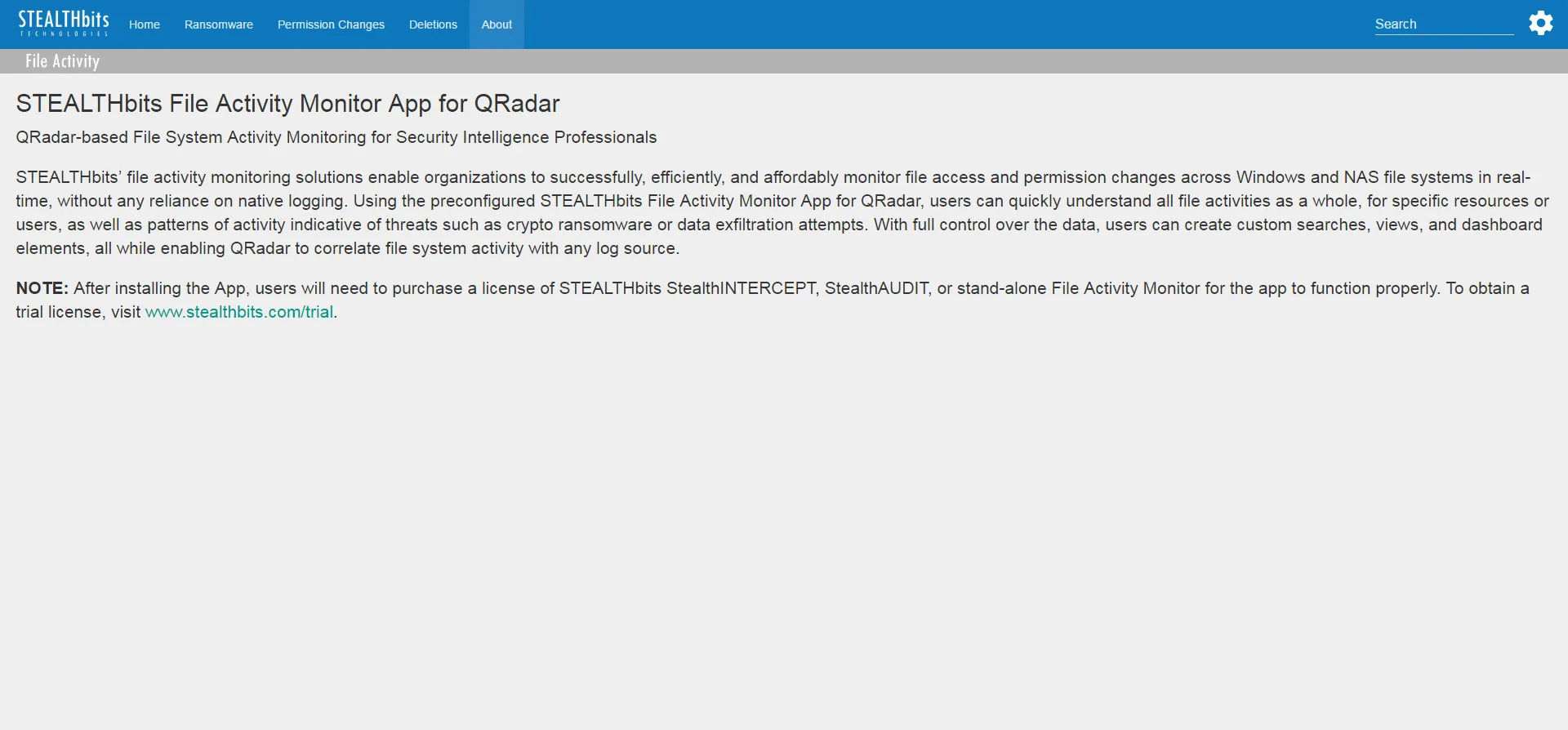
Information on how to obtain a license for the applicable Stealthbits software is included.
Deletions Dashboard
The Deletions dashboard contains the following cards:
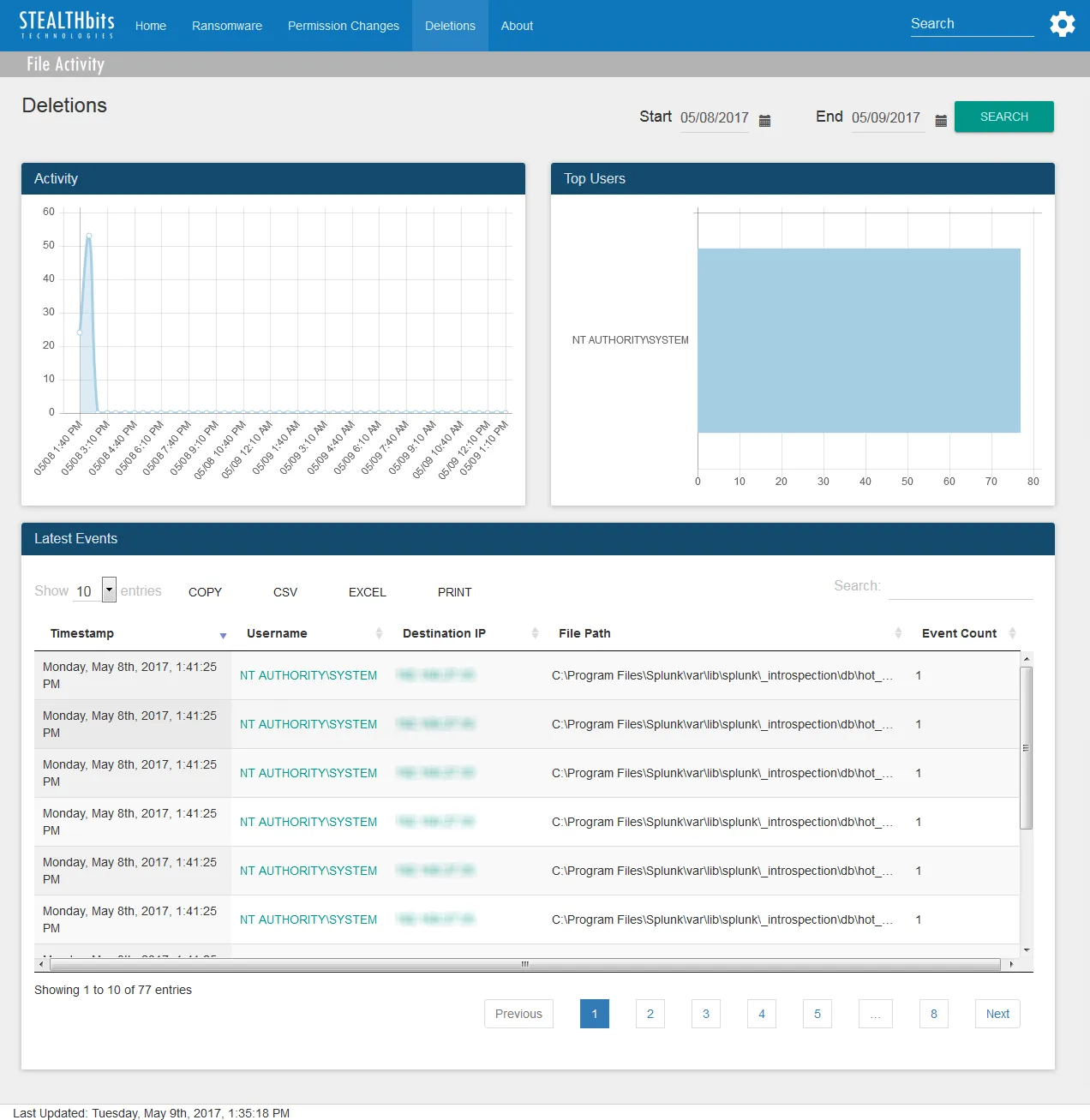
-
Activity – Timeline of all deletion events over the specified time interval
-
Top Users – Displays up-to the top five users associated with deletion events over the specified time interval
-
Latest Events – Tabular format of all deletion events which occurred over the specified time interval
- See the Table Card Features topic for additional information.
The time interval is identified in the upper-right corner with the Start and End boxes. This is set by default to the “past day,” or 24 hours. To search within a different interval, either manually type the desired date and time or use the calendar buttons to set the desired date and time interval. Then click Search to refresh the card data.
Home Dashboard
The File System Activity Home dashboard contains the following cards:
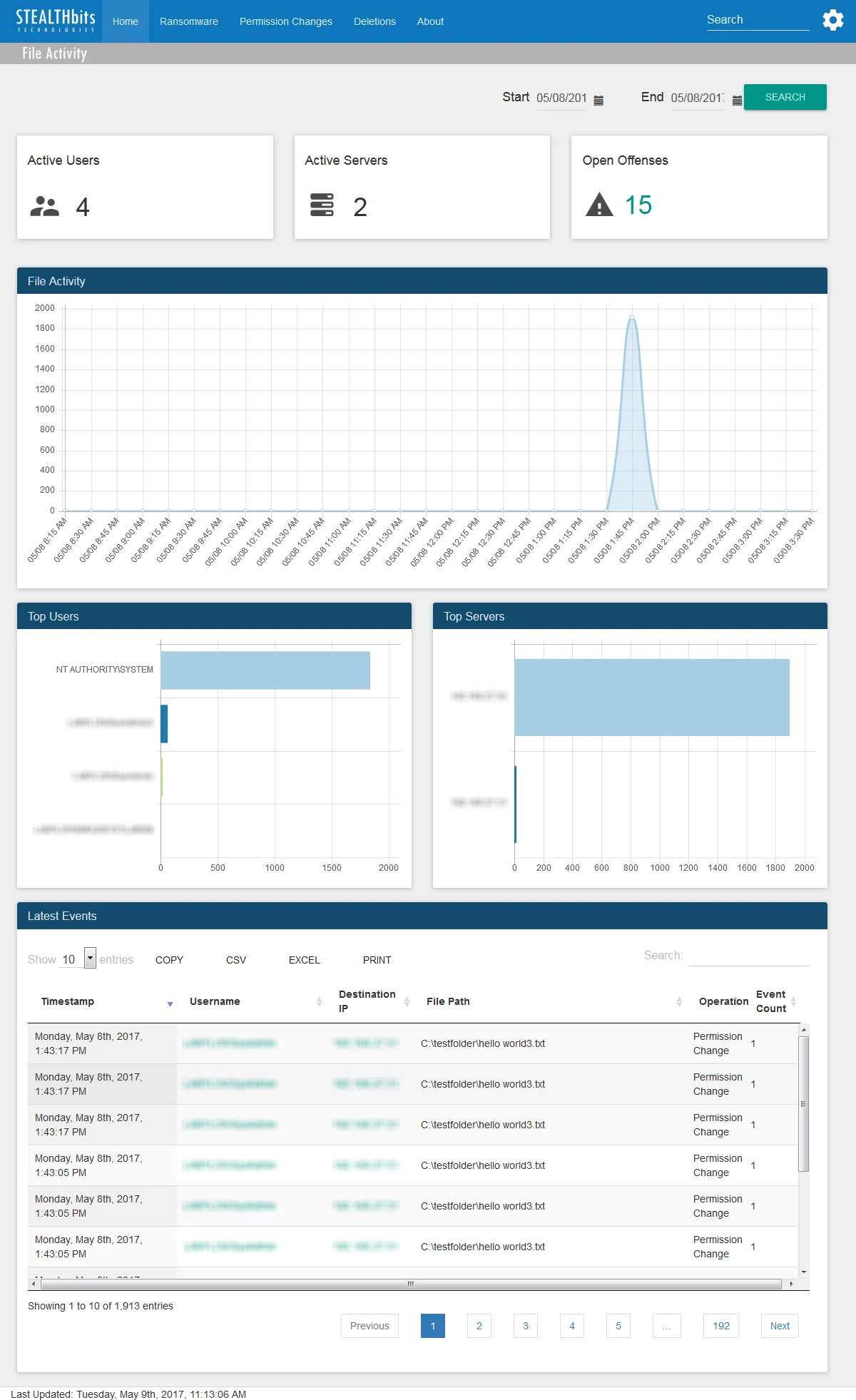
-
Active Users – Number of distinct users recorded performing any type of file activity to/from any host over the specified time interval
-
Active Servers – Number of distinct servers accessed (destination IP Addresses) with any type of file activity recorded over the specified time interval
-
Open Offenses – Number of ransomware offenses detected within QRadar from the file activity event data
- The value for this card is a hyperlink to the Ransomware Dashboard.
-
File Activity – Timeline of all file activity over the specified time interval
-
Top Users – Displays up-to the top five users associated with file activity over the specified time interval
-
Top Servers – Displays up-to the top five servers (destination IP Addresses) associated with file activity over the specified time interval
-
Latest Events – Tabular format of all file activity events which occurred over the specified time interval
- See the Table Card Features topic for additional information.
The time interval is identified in the upper-right corner with the Start and End boxes. This is set by default to the “past day,” or 24 hours. To search within a different interval, either manually type the desired date and time or use the calendar buttons to set the desired date and time interval. Then click Search to refresh the card data.
Host Investigation Dashboard
The Host Investigation dashboard only appears when a search is conducted. This can be done by clicking a hyperlink within the Destination IP column of a table card. Alternatively, type the complete host IP Address in the Search box on the right side of the navigation bar.
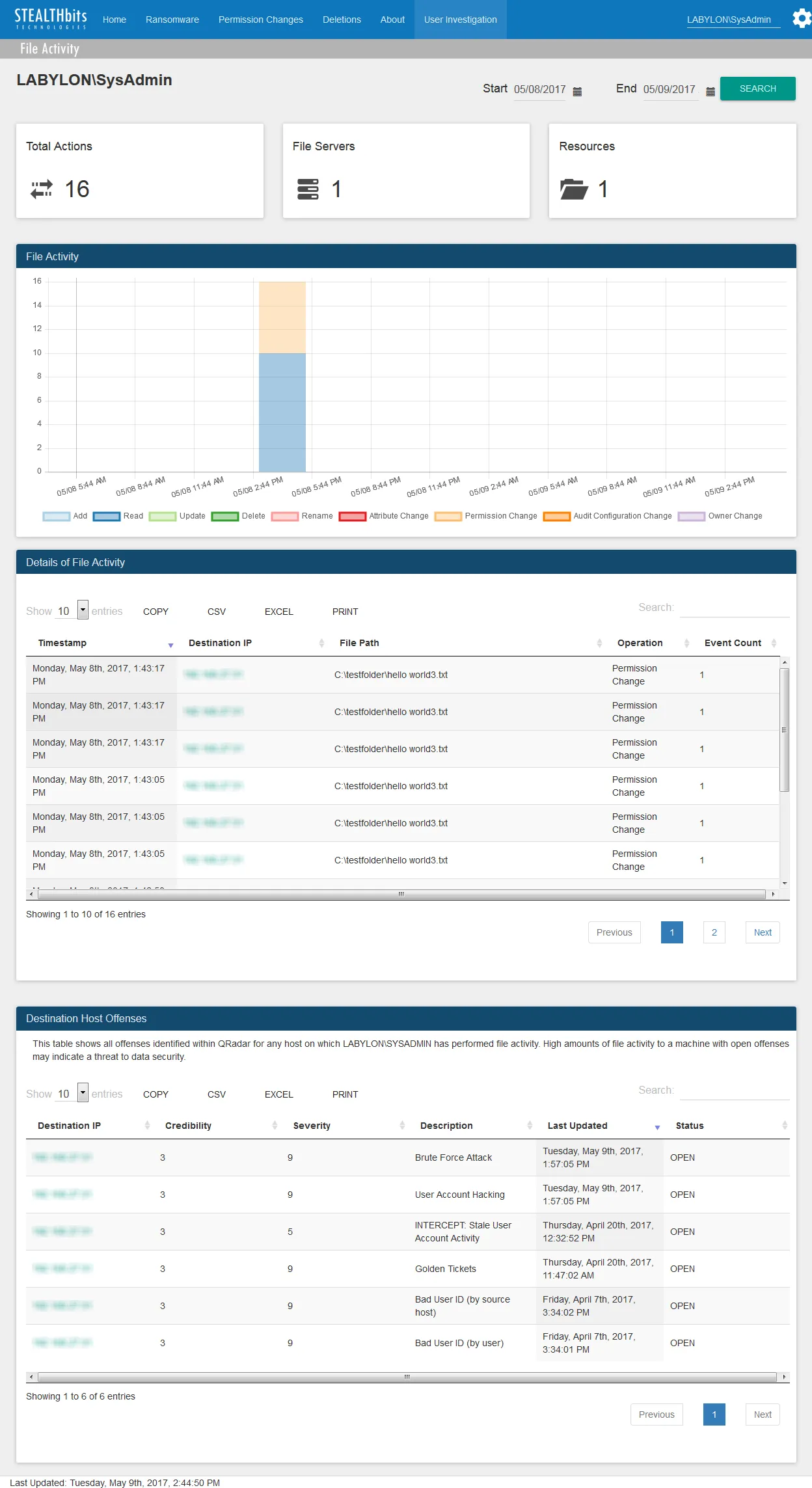
The Host Investigation dashboard contains the following cards:
-
Total Actions – Number of all file activity events associated with the host over the specified time interval
-
Users – Number of usernames associated with the host over the specified time interval
-
Resources – Number of distinct files associated with the host over the specified time interval
-
File Activity – Timeline of all events associated with the host over the specified time interval
- The graph values can be toggled on an off by clicking on individual elements in the legend.
-
Details of File Activity – Tabular format of all file activity events associated with the host which occurred over the specified time interval
- See the Table Card Features topic for additional information.
-
Destination Host Offenses – QRadar offenses associated with the host which occurred over the specified time interval
- See the Table Card Features topic for additional information.
The time interval is identified in the upper-right corner with the Start and End boxes. This is set by default to the “past day,” or 24 hours. To search within a different interval, either manually type the desired date and time or use the calendar buttons to set the desired date and time interval. Then click Search to refresh the card data.
Permission Changes Dashboard
The Permission Changes Dashboard for QRadar shows information on changes made to permissions using various metrics.
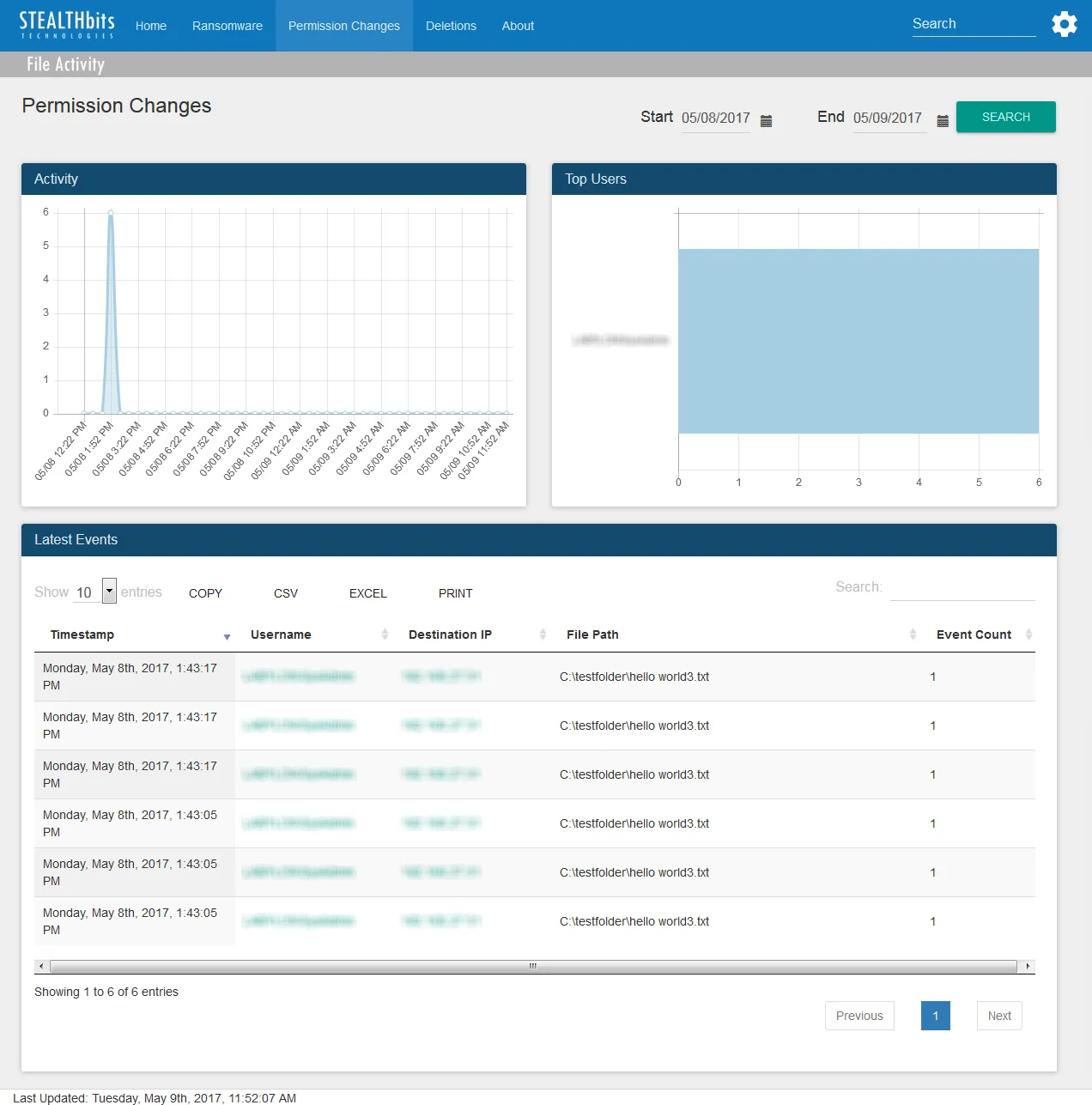
The Permission Changes dashboard contains the following cards:
-
Activity – Timeline of all permission change events over the specified time interval
-
Top Users – Displays up-to the top five users associated with permission change events over the specified time interval
-
Latest Events – Tabular format of all permission change events which occurred over the specified time interval
- See the Table Card Features topic for additional information.
The time interval is identified in the upper-right corner with the Start and End boxes. This is set by default to the “past day,” or 24 hours. To search within a different interval, either manually type the desired date and time or use the calendar buttons to set the desired date and time interval. Then click Search to refresh the card data.
Ransomware Dashboard
The Ransomware Dashboard for QRadar shows a list of suspected ransomware events.

The Ransomware dashboard contains the following cards:
-
Offenses – List of offenses detected within QRadar from the file activity data as a potential ransomware attack
- See the Table Card Features topic for additional information.
-
Details of Ransomware Attack – Tabular format of all file activity events for the selected offense which occurred over the specified time interval
- Only visible after clicking Search on an offense
- See the Table Card Features topic for additional information.
-
Breakdown of File Types – Pie chart of the top eight file extensions of the affected files for the selected offense
- Only visible after clicking Search on an offense
The offenses generated within QRadar are based upon the Stealthbits: Ransomware Detected rule that is packaged with this application. In order to adjust this rule to better suit an organization’s needs, please refer to the IBM QRadar Rule management article on how to modify rules.
User Investigation Dashboard
The User Investigation dashboard only appears when a search is conducted. This can be done by clicking a hyperlink within the Username column of a table card. Alternatively, type the complete user name in the Search box on the right side of the navigation bar.

The User Investigation dashboard contains the following cards:
- Total Actions – Number of all file activity events associated with the user over the specified time interval
- File Servers – Number of destination IP Addresses associated with the user over the specified time interval
- Resources – Number of distinct files associated with the user over the specified time interval
- File Activity – Timeline of all events associated with the user over the specified time interval
- The graph values can be toggled on an off by clicking on individual elements in the legend.
- Details of File Activity – Tabular format of all file activity events associated with the user
which occurred over the specified time interval
- See the Table Card Features topic for additional information.
- Destination Host Offenses – QRadar offenses associated with the destination IP Addresses accessed
by the user during the specified time interval
- See the Table Card Features topic for additional information.
The time interval is identified in the upper-right corner with the Start and End boxes. This is set by default to the “past day,” or 24 hours. To search within a different interval, either manually type the desired date and time or use the calendar buttons to set the desired date and time interval. Then click Search to refresh the card data.
Offenses
The Activity Monitor App for QRadar feeds a couple of QRadar Offenses.

While the Ransomware Dashboard reports on incidents of Ransomware attacks monitored by StealthINTERCEPT, the following offenses may be generated by the Stealthbits File Activity Monitor App.
| QRadar Offense | Definition |
|---|---|
| INTERCEPT: File System Attacks (By User) | Significant number of file changes made by an account in a short time period |
| Stealthbits: Ransomware Detected | Threshold-based Ransomware Rule |
Netwrix File Activity Monitor App for QRadar
Netwrix File Activity monitoring solutions enable organizations to successfully, efficiently, and affordably monitor file access and permission changes across Windows and Network Attached Storage (NAS) file systems in real-time. Using the preconfigured Netwrix File Activity Monitor App for QRadar, users can quickly understand all file activities as a whole, for specific resources or users, as well as patterns of activity indicative of threats such as crypto ransomware or data exfiltration attempts. With full control over the data, users can create custom searches, all while enabling QRadar to correlate file system activity with any log source.
This document describes how to integrate Netwrix products with the Netwrix File Activity Monitor App for QRadar found in the IBM X-Force Exchange. Any Netwrix products can be configured to monitor file system activity and send the monitored events to QRadar. After installing this app, ensure that either the Activity Monitor, Threat Prevention, or Access Analyzer has been configured to send events to QRadar. See the Netwrix Technical Knowledge Center on the Netwrix website for additional information.
App Installation in QRadar
Download the [Stealthbits File Activity Monitor App for QRadar](https://exchange.xforce.ibmcloud.com/hub/extension/STEALTHbits Technologies:STEALTHbits File Activity Monitor) from the IBM X-Force App Exchange. After downloading the Stealthbits File Activity Monitor App for QRadar, follow the steps to install it within QRadar.
Step 1 – Click on the Admin tab within QRadar.
Step 2 – Under System Configuration, click Extensions Management.
Step 3 – Click Add in the top-right corner of the window. Navigate to the location where you downloaded the app, and select it. Check the Install Immediately checkbox, and then click Add.
Step 4 – When the Validating Install window is finished processing, check the Overwrite option. Then click Install.
Step 5 – Close the Extensions Management window, and then select the File Activity Monitor tab within QRadar.
The File Activity Monitor tab will appear within QRadar. It is necessary for the QRadar SEC token to be saved to the Settings interface of the File Activity Monitor App. See the Settings topic for additional information.
Initial Configuration of the QRadar App
Follow the steps to configure QRadar to receive data from Stealthbitsproducts.
Step 1 – Determine the IP Address of the QRadar Console, e.g. run the ifconfig command. This information is required for the following sections:
- See the Syslog Tab section of the Stealthbits File Activity Monitor User Guide for information on how to configure the Stealthbits Activity Monitor to send data to QRadar.
- See the SIEM Tab section of the StealthINTERCEPT Admin Console User Guide for information on how to configure StealthINTERCEPT to send data to QRadar.
Step 2 – Navigate to the Admin tab in the QRadar web interface and click Data Sources.
Step 3 – Select Log Sources.
Step 4 – View the Log Sources list. If the data source was not automatically created, click Add and enter the following information:
- Log Source Name – Enter a descriptive name to identify the data source
- Log Source Description – Enter a description of the data source
- Log Source Type – Stealthbits StealthINTERCEPT
- Use this source type for both the Stealthbits Activity Monitor and StealthINTERCEPT.
Step 5 – Test that the configuration is working correctly. Check the Log Activity page inside of the web console for QRadar. There should be logs of events that are generated as soon as QRadar starts receiving data. If there are no events, use a packet sniffer to ensure that packets are being sent correctly between the hosts, and diagnose any possible network issues.
- Protocol Configuration – Select Syslog
- Log Source Identifier – Enter the host name or IP Address of the host where the Stealthbits Activity Monitor Console OR StealthINTERCEPT is installed
- Then click Save. Remember, prior to using the StealthbitsFile Activity Monitor App for QRadar, the related Stealthbits product must be configured to send data to QRadar.
The Stealthbits File Activity Monitor App for QRadar can now display activity data from either the Stealthbits Activity Monitor or StealthINTERCEPT.
Settings
Use the gear icon next to the Search box to open the Settings interface. It is necessary for the QRadar SEC token to be saved to the Settings interface.

The More information link will open the IBM Knowledge Center with information on generating the QRadar SEC token. Once the token is generated, copy and paste it here and click Save.